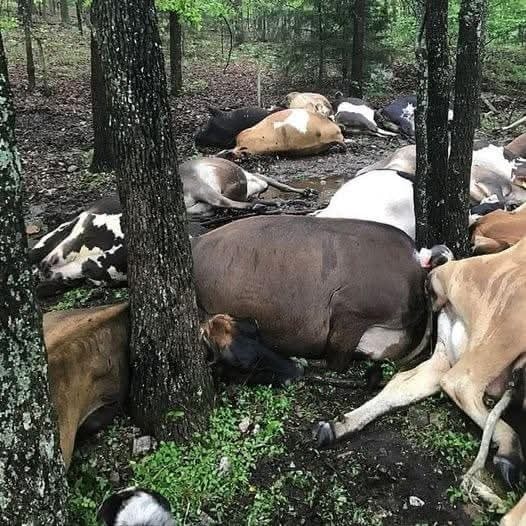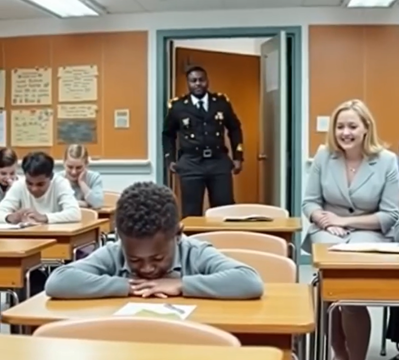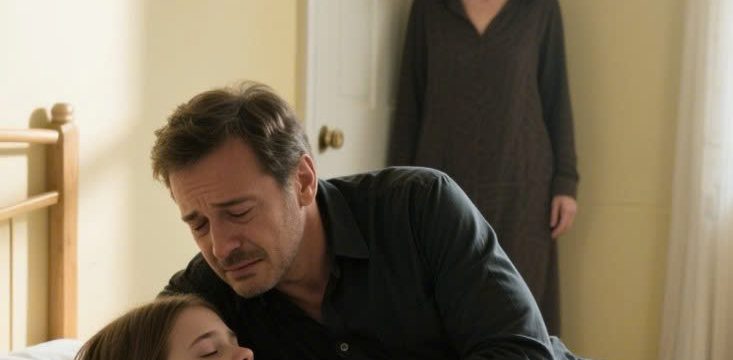For most farmers, spring storms in Missouri are simply part of life—loud claps of thunder, heavy rainfall, and the occasional flash of lightning passing quickly over rolling fields. But for one family in Wright County, what began as an ordinary weather pattern ended in an unimaginable loss. When dairy farmer Jared Blackwelder walked out to his pasture one Saturday evening to bring his cows in for milking, he expected the usual routine. Instead, he was met with a heartbreaking sight—32 of his dairy cattle lying together, lifeless, as though they had all fallen at once. What appeared to be the work of a single lightning strike had taken not only his herd but also a major part of his livelihood.

Earlier that morning, Jared and his wife Misty had listened to the storm roll through while tending their farm. Thunder had rumbled in the distance, accompanied by sheets of rain. For them, the noise was nothing unusual, just the familiar rhythm of Missouri’s spring weather. The storm eventually passed, leaving behind damp fields and a heavy sky. There was no indication of the devastation still to come. By the time Jared returned to round up the cows for their evening routine, the storm was long gone, but its impact remained in the most devastating way imaginable.
Neighbors and local farm leaders were stunned by the loss. “Lightning strikes happen, but what makes this case so unusual is the sheer number of cattle lost in one instant,” explained Stan Coday, president of the Wright County Missouri Farm Bureau, in an interview with CBS News. A veterinarian confirmed that lightning was indeed the cause of death, noting that the cows likely huddled together beneath trees for shelter at the worst possible time. When the strike hit, it carried through the ground beneath them, ending their lives in an instant.
For Coday, who has dealt with livestock losses due to weather himself, the tragedy was a sobering reminder of how vulnerable farming can be. “You’re at the mercy of the weather,” he said, reflecting on how unpredictable nature can upend years of hard work. Farmers are no strangers to challenges, from floods to droughts to disease, but losing an entire herd in a single moment is almost beyond comprehension.
For Blackwelder, the loss went far deeper than money. “They’re not just animals, and while they’re not pets, dairy cattle are different,” he told the Springfield News-Leader. “You see them twice a day, every day. I raised every single one of them. It knocks you hard.” His words revealed the emotional weight of the tragedy—these were not nameless animals, but creatures he had nurtured and cared for daily, forming bonds that only a farmer can truly understand.
Still, the financial consequences are staggering. Each certified organic cow was valued at $2,000 to $2,500, bringing the total loss to nearly $60,000. Blackwelder did carry insurance, but even he was unsure if such a rare and specific event would be covered under his policy. Many farmers, as Coday explained, do not insure their herds at all because the premiums can be high and the risks difficult to predict. For those without coverage, an event like this could wipe out not only their animals but their entire livelihood. “If you lose a cow, you’ve lost everything,” Coday said plainly, emphasizing the precarious position livestock farmers often face.
Adding to the heartbreak was the reality that the animals could not even be salvaged for meat or other uses. “Those animals had been lying there for hours,” Coday explained. “They were damaged and would never be fit for human consumption.” This meant that Blackwelder’s loss was total—there was no way to recover even a portion of the financial blow. The tragedy was final in every sense.
Missouri’s generally mild climate makes barns and large shelters less common for dairy herds, and on farms like Blackwelder’s, cattle often graze in open pastures. While this is typically safe and healthy, it does leave animals more vulnerable during sudden thunderstorms. Lightning strikes, though rare, can become catastrophic when large groups of livestock gather closely together under trees or near fences, which can conduct electricity. Farmers know these risks, but nature’s unpredictability means prevention is not always possible.
The incident quickly spread across the farming community, serving as both a cautionary tale and a reminder of the fragility of agricultural life. Other farmers shared their own experiences of losing animals to weather events, expressing sympathy and solidarity with the Blackwelder family. Conservation groups and agricultural organizations also highlighted the story as an example of why risk management and insurance remain crucial, even when the chances of such a loss seem remote.
For the Blackwelders, however, the tragedy is personal and profound. These were animals they had raised from calves, animals they depended on not only for income but for the rhythm of their daily lives. Each morning and evening milking was part of a routine that tied them to their land and livelihood. To lose all of them at once was not just an economic blow—it was a disruption of their very way of life.
What began as a routine thunderstorm ended in devastation that few could have imagined. The story of the Blackwelder farm is a stark reminder of the delicate balance between human industry and the uncontrollable forces of nature. Farmers live with this reality every day, knowing that in a single moment, everything can change. While insurance, better safety measures, and awareness can help, they can never fully eliminate the risks that come with working so closely with animals and the land.
In the end, the tragedy underscores both the strength and vulnerability of farming families. It reveals the emotional connections farmers develop with their herds and the financial risks they shoulder in pursuit of a livelihood that feeds communities far beyond their own fences. For Jared and Misty Blackwelder, the loss of 32 cows in a single lightning strike will remain an unforgettable chapter in their story—one that speaks to the power of nature, the fragility of life, and the resilience required to carry on in the face of unimaginable loss.





